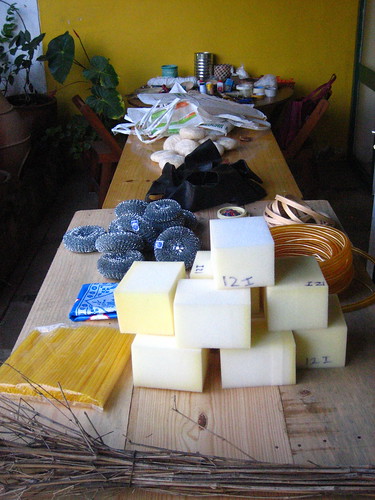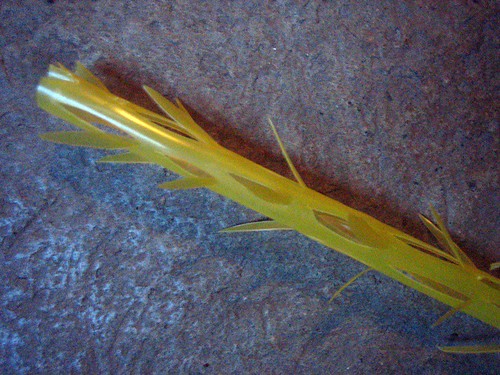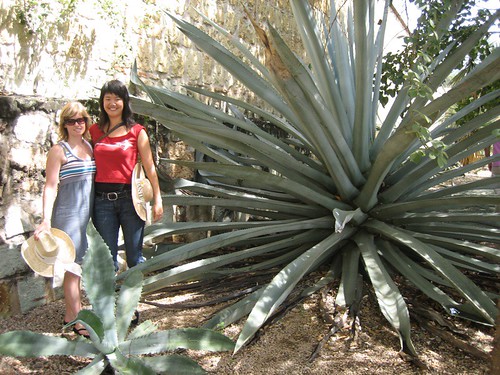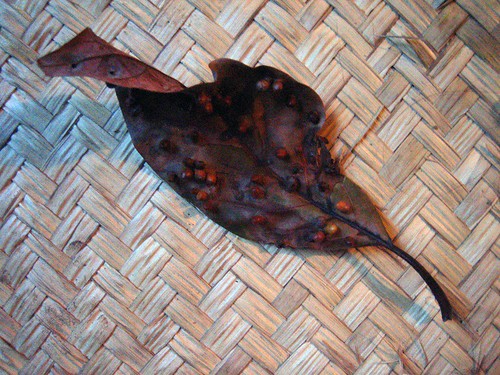1st week: Meeting and choosing the artisan groups
2nd week: Concepting and collaboration
3rd Week: Production and preparation for our show
We started off our second week in Oaxaca by inviting the artisans to our house to play around with materials and brainstorm new designs. For those of you who wonder what exactly it is we do in art school, pay attention here. Randy (J's Dad) is always asking me how it is that people in creative fields stay fresh and generate new ideas on command. Well, I definitely run into walls and feel lethargic at work from time to time, but exercises like the ones we did on Monday and Tuesday with our artisans (which may seem like a colossal waste of time) do help generate inspiration and reroute my usual creative process.
I should probably mention that the artisans NEVER do anything like what we did on Monday and Tuesday (and, I promise, I'll get to explaining what we did in a minute here). They see their trade as work, not as play. Huaraches, woven palm baskets, candles, fireworks, and red clay are a way to feed their families, not art. In particular, Don German and Dona Clara and the palm weavers are living just a bit above the poverty level. I think candles and fireworks are a little more stable financially, but not rich by any means. The one exception is the red clay lady, who is pretty well off. But even she got a lot out of the exercises because we started at a very basic level, just playing with materials without any preconceived notion of right or wrong. This is very much the opposite of what they do. Before she begins working, she thinks, "I will make a cup." She never thinks, "I have no idea what this piece will look like. I will just start doing it." Which is exactly what we did.

When we met downstairs on Monday morning, we were greeted by a table full of raw materials that we purchased at the Abastos market on Saturday: foam blocks, straws, banana leaves, wool sponges, loofahs, etc. We were told to choose one material that we wanted to play with. I chose plastic straws (along with Dona Clara and Dina). Once we got settled in our material groups, we were told that we would be doing a series of 5 minute exercises. The intention of these exercises was the see how far we could push the limitations of our materials. For example, in the first exercise, we could do anything we wanted to our materials as long as we were subtracting from the form: burning, cutting, stretching, whatever. The point was to see how far we could push the material before it started to change in nature. At what point does a straw lose its "straw-ness"? Here is an experiment I did early on in the day. I like how the straw ceases to look like a manufactured material and starts to take on properties found in nature. It kind of remind me a little of an agave plant:


I know all of this sounds a little crazy to people who don't go to art school, but we do this kind of thing all the time. Not only does it allow you to understand your material fully, but this kind of intellectual engagement is precisely what keeps you interested in the project. Well, it's what keeps me interested, anyway.
After we subtracted from the material, we were allowed to add back in with the pieces we subtracted. Next we were to add in other materials; and then to interact with fixed objects, like the table, or a tree, or the wall. Again, I know this all sounds very weird. Here is one of the pieces I really liked. I love the contrast of safe (the foam) and dangerous (the nails and staples). I also like how the addition of the extra materials really brings out the spongy properties of the foam:

Finally, we were told to take 5 minutes to walk out on the street, in the back yard, or in the house, and find an object that interested us: a leaf, a flower, a pine cone, whatever. The point was to stop us from thinking of the material for a minute and look to nature or our environment for inspiration. When we returned from our object gathering, we were instructed to use whatever material we wanted to capture the poetic qualities of the object we chose. We were not to recreate the object, but for instance, if we the object we chose was a flower, what did we like about the flower? the way it opened? the way its petals curled? And how could we transfer that concept into our material? The artisans had a very difficult time with this assignment and most of them just recreated the object in another material. Here is a good example of this concept. See the little nubs on the leaves? These get translated into foam and string:


The following day, we did some similar exercises with our actual materials, but this time working in our artisan groups. Basically, the point was to explore the material and see what kind of shapes and forms we could come up with that were interesting. At the end of the day, we had a critique of our work to see what sorts of things we could make out of our explorations if we changed the scale, or twisted it, or folded it, etc. Some really interesting things came out of that experimentation. The experience of working with Don German was somewhat difficult. In addition to the language barriers, we felt that he was being very stubborn and making the same shape over and over again (the same shape from last year's collaboration--one which we did not find successful). But, when we critiqued with Raul, he seemed pretty pleased with all the forms that we made. Problem solved. :)
No comments:
Post a Comment